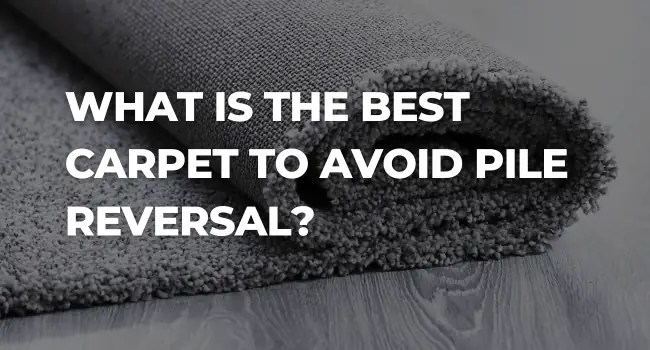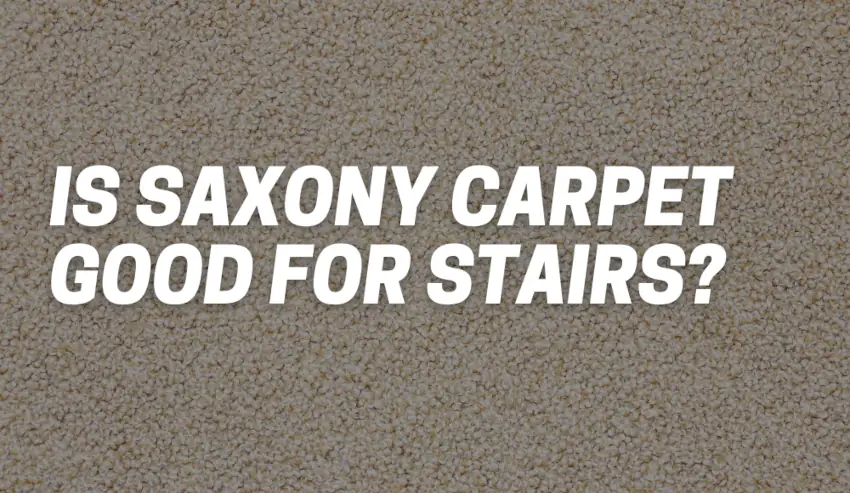Last updated on October 29th, 2023 at 02:55 am
Carpeting can add warmth and comfort to any room, but one issue that often plagues carpet owners is “pile reversal.” If you’ve ever noticed unsightly patterns or patches in your carpet where the fibers seem to be going in different directions, you might be dealing with pile reversal.
In this comprehensive guide, we will delve into the world of carpet nap, pile reversal, pile direction, causes, and most importantly, how to choose the best carpet to avoid pile reversal. Let’s unravel the mysteries of carpet pile together.
What is Carpet Nap?
Before we dive into the intricacies of pile reversal, let’s start with the basics.
The term “nap” refers to the direction in which the fibers of a carpet naturally lay. It’s similar to petting a cat – run your hand one way, and the fur is smooth; run it the other way, and you’ll feel resistance.
The same principle applies to carpet fibers. When installed correctly, the nap should flow uniformly in one direction, creating a consistent and inviting look.
How to find the direction of the carpet nap
What is Pile Reversal?
Pile reversal, also known as “watermarking” or “pooling,” occurs when the carpet fibers change direction, causing certain areas to appear lighter or darker than the rest of the carpet.
This phenomenon can create visible patterns that may resemble water stains, shadows, or trails. Pile reversal is a common concern among homeowners, and it can be frustrating to deal with.
What is Carpet Pile Direction?
Carpet pile direction is the orientation of the fibers in a carpet. When carpet is manufactured, the fibers are typically aligned in a specific direction, known as the “pile direction.” This direction is important because it affects the appearance and performance of the carpet.
Carpet Pile Reversal Causes
Understanding the causes of pile reversal is crucial in preventing it. Several factors contribute to this phenomenon:
- Foot Traffic: Over time, heavy foot traffic can cause the carpet fibers to bend and change direction. This is especially common in areas with concentrated foot traffic, like hallways and entryways.
- Furniture Weight: The weight of furniture and heavy objects can compress the carpet fibers, causing them to shift and create pile reversal.
- Humidity Changes: Fluctuations in humidity levels can affect the carpet fibers, leading to pile reversal. High humidity can make the fibers swell and shift, while low humidity can cause them to contract.
- Installation Issues: Improper installation, such as not following the recommended pile direction, can contribute to pile reversal.
Is Pile Reversal a Fault?
Pile reversal is not a manufacturing defect or fault in the carpet. It is a natural occurrence that can happen with any carpet over time. While it may be frustrating, it doesn’t affect the carpet’s performance or durability.
Can Pile Reversal Cause Damage?
Pile reversal itself does not cause structural damage to the carpet. However, it can be unsightly and may require additional maintenance to improve the appearance of affected areas.
Can You Bring the Pile Back Up on a Carpet?
Unfortunately, once pile reversal occurs, it’s challenging to bring the affected fibers back to their original direction. However, there are some techniques you can try to improve the appearance of pile-reversed areas, which we’ll discuss later in this guide.
How Do You Fix a Carpet Pile Reversal?
While complete reversal of pile direction is unlikely, you can take steps to minimize the appearance of pile reversal:
- Professional Cleaning: Hiring a professional carpet cleaner can help improve the overall appearance of the carpet, including pile-reversed areas.
- Steam Cleaning: Steam cleaning can help relax the carpet fibers and reduce the appearance of pile reversal.
- Carpet Raking: Using a carpet rake or brush in the direction of the pile can temporarily improve the appearance of pile-reversed areas.
- Regular Vacuuming: Regular vacuuming can prevent dirt and debris from accumulating in pile-reversed areas, making them less noticeable.
—
What Is the Best Carpet to Avoid Pile Reversal?
Now, let’s get to the heart of the matter – how to choose the best carpet to avoid pile reversal. When selecting carpet for your home, there are several factors to consider to minimize the risk of pile reversal:
Fiber Type
- Nylon: Nylon carpets tend to be more resilient and less prone to pile reversal than other fiber types. They have excellent elastic properties, which allow them to bounce back even after compression.
- Wool: Wool carpets are naturally resistant to pile reversal. Wool fibers have a strong, natural crimp that helps them maintain their shape and direction.
Pile Height and Density
- Low Pile: Carpets with a low pile height are less likely to exhibit pile reversal because the shorter fibers are less prone to bending and shifting.
- High Density: Carpets with a higher density of fibers distribute foot traffic and furniture weight more evenly, reducing the likelihood of pile reversal.
Proper Installation
- Professional Installation: Ensure that your carpet is installed by a professional who follows the manufacturer’s guidelines for pile direction.
- Choose a Reputable Installer: Selecting an experienced and reputable installer is crucial to avoid installation-related pile reversal issues.
Maintenance
- Regular Cleaning: Keeping your carpet clean and free from dirt and debris can help maintain its appearance and reduce the risk of pile reversal.
- Use Furniture Pads: Placing furniture pads under heavy objects can prevent them from compressing the carpet fibers.
What Is a Reversible Carpet?
Some carpets are designed to be “reversible,” meaning they have a consistent appearance regardless of which side is facing up. Reversible carpets can be a good choice if you’re concerned about pile reversal because you can simply flip the carpet if you notice any signs of reversal.
Additional Tips for Carpet Care
Beyond choosing the right carpet, there are some general tips and practices you can adopt to ensure the longevity and appearance of your flooring:
Use Doormats
Place doormats at entryways to reduce the amount of dirt and debris that enters your home. This can help prevent abrasive particles from damaging your carpet fibers and contributing to pile reversal.
Remove Shoes
Encourage family members and guests to remove their shoes when entering your home. Shoes can bring in dirt, gravel, and other abrasive materials that can accelerate wear and tear on your carpet.
Rearrange Furniture
Periodically rearrange your furniture to distribute weight and foot traffic more evenly across your carpet. This can help prevent the formation of permanent indentations and pile reversal in specific areas.
Rotate Area Rugs
If you have area rugs placed on your carpet, rotate them occasionally. This can help ensure that wear and compression are distributed evenly across the underlying carpet.
Address Spills Promptly
Act quickly to clean up spills and stains on your carpet. The longer a spill sits, the more likely it is to penetrate the fibers and become challenging to remove.
Regular Vacuuming
Maintain a consistent vacuuming schedule to remove dirt, dust, and debris from your carpet. Be sure to use a vacuum cleaner with appropriate settings for your carpet type.
Conclusion
In summary, pile reversal is a natural occurrence in carpets that can be caused by factors like foot traffic, furniture weight, and humidity changes.
While it may not be completely preventable, choosing the right carpet type, pile height, and density, as well as ensuring proper installation and maintenance, can significantly reduce the risk.
Additionally, reversible carpets offer a convenient solution for mitigating the effects of pile reversal. So, when it comes to selecting the best carpet for your home, consider these factors to enjoy a beautiful and long-lasting flooring solution that resists the challenges of pile reversal.


